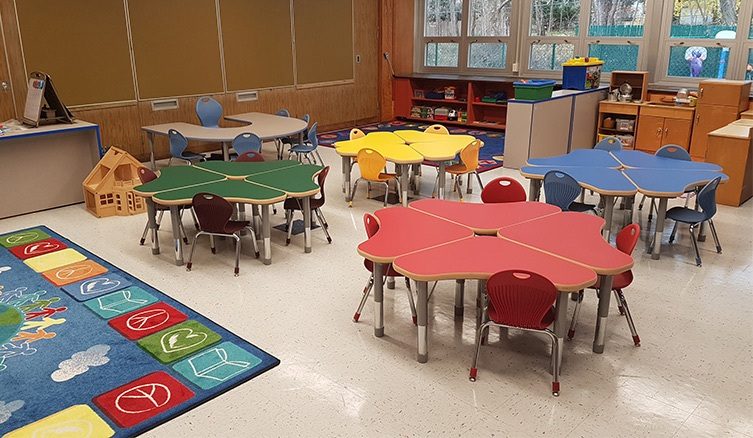Rows vs. Hubs: Desk Layout in the Impactful Classroom
By Academia Furniture
Posted May 4, 2017 in Learning Environments
One of the hottest current trends in the educational system is collaborative learning (CL) which requires students to sit at desks arranged in a pod or hub, instead of the more traditional layout of front-facing desks, for most or all of a class. Now, having a group of students sitting facing each other and not the front of the classroom during class may sound counter intuitive, however, educational experts and teachers alike sing the praises of this unorthodox classroom layout choice.
In order to understand how to design a classroom that can accommodate both traditional row seating and pod desk layouts, it’s important to understand a little bit about collaborative learning and the amazing advantages it offers to students and teachers alike.
Probably the most important things that CL does is promoting “positive interdependence”, a term coined by Dr. Hari Srinivas of the Global Development Research Center, an independent non-profit think tank out of Kobe, Japan. Basically, positive interdependence is the concept that each of us is both individually and collectively responsible for the success of the whole. In other words, the success of the group depends on how well each member performs individually for personal gain but with the ultimate goal of achieving the success of the group.
The collaborative learning method forces students to work both independently and together to reach a particular goal such producing a project or presentation, taking a group test, or coming up with homework answers. Having to work face to face as a team means that no student can truly “detach” or “hide” from the group. In a best case scenario, the stronger students in the hub will be compelled to help the weaker ones, something that benefits both the individual and the group.
CL has been shown to help children develop strong interpersonal abilities including communication and leadership skills. Through CL, students learn how to depend on others and how to themselves grow more dependable; how to become more trusting and more trustworthy at the same time, and how to tell when it’s time to lead and when it’s time to follow.
In short, CL promotes and helps students to build and strengthen the tools that they will need to become thriving and productive adults including the ability to co-operate, the ability to make decisions, and the ability to resolve conflicts. CL creates a community environment within the classroom.
Educators also greatly benefit from CL in a pod layout. In a post on the popular educator-based blog “Everybody is a Genius”, Sarah, a 10+ year math teaching veteran, writes about making a permanent switch from the traditional row class layout to hubs of 4 students each, something she had been resisting for a long time. Her main concern was that when facing each other, students would be more likely to socialize and that both monitoring the behavior and attending to the needs of the students would be more difficult. However, her experience proved quite the opposite. “My favorite thing”, she writes, “is that [desk hubs] make it so much easier for me to get around to help students and check work…Instead of just moving around the room from one student to the next, I can move from table to table and address all issues or check all work at once”.
A hub layout in a classroom can also potentially shorten the amount of time a teacher spends disciplining the class. First of all, hub seating focuses the students attention inwards and makes it harder to turn to talk to others. It also empowers the students themselves to curtail bad or disruptive behavior. Since they are responsible for each other and the success of the group, students are less likely to waste the group’s time by acting out.
In terms of design, a hub based classroom should include modular desks that are configurable and are meant to be attached to each other like puzzle pieces. Having the desks on casters is a plus, as is having the teacher’s desk specifically designed to either stand alone at the front of the classroom or be easily moved to join a hub. This means that the teacher can bring any visual aids, laptops or tablets right to the students without having to carry it in his/her hands.
Clearly, collaborative learning facilitated by a pod seating arrangement, is an optimum way of helping students reach their full potential both individually and as part of a group. The skills and abilities they pick up along the way will help them become adults who are able to be a part of a team, to be accountable for their actions and to truly understand the concept that collaboration is oftentimes better than competition.
